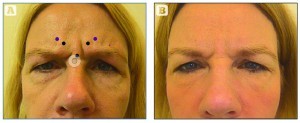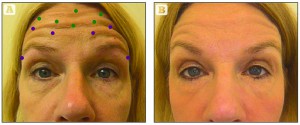Loss of volume and sagging facial contours, as well as persistent hyperkinetic lines and rhytides, are typical indications for non-invasive facial rejuvenation treatments such as dermal filler and botulinum toxin type A (BoNT A) injections. Facial ageing is a complex, three-dimensional process, which affects all anatomic structures from the skin to the subdermal fat pads and the facial retaining ligaments. The typical and first sign of ageing that patients complain about is the appearance of the glabellar fold, followed by persistent forehead lines and crow’s feet. Loss of volume is typically detected in the nasolabial folds, reflecting the consequences of a loss of volume in the cheeks and upper mandible areas1. As a result, non-invasive therapies such as dermal filler and BoNT A injections are moving away from single-fold-fixing, to a global restoration and three-dimensional reshaping of the facial structures2. The target here is to maintain and optimise the facial features — always aiming to achieve a natural look.
To relax facial muscles and smooth out facial wrinkles, treatments with botulinum toxin type A (BoNT A) mark the gold standard in aesthetic medicine. The most recent and ‘youngest’ BoNT A on the market is Incobotulinumtoxin A: Xeomin®, approved for medical indications in Europe (2005) and the US (2008), and Bocouture® for aesthetic indications (Europe 2008/US 2011). This formulation of BoNT A is free from complexing proteins, and therefore presents a low immunogenic potential3, 4; Incobotulinumtoxin A does not require a cold chain5.
When it comes to biodegradable dermal filler material, all those that are FDA-approved and/or CE-marked offer good efficacy and safety. However — to focus on just some properties of fillers — there are significant differences between hyaluronic acid (HA)-based fillers with regard to composition, biointegration, and their physical and chemical properties. When smoothing out superficial wrinkles, it has been shown that monophasic polydensified HAs integrate intradermally within the injected tissue without the risk of inflammation or lymphocytic infiltration6, and with no risk of the Tyndall effect. Dextranomer beads can increase the longevity of HA-based fillers, as they induce collagen stimulation7. The biodegradable calcium-based filler, calcium hydroxylapatite (CaHA), has a far higher volumising capacity as its elasticity and viscosity are much higher compared to HA fillers8. As CaHA additionally lacks hygroscopic properties (in contrast to HA), its lifting capacity is very precise. Furthermore, the extrudability of CaHA through even a 1.5-inch flexible cannula, is effortless; as this filler is composed of uniform, spherical and non-deformable particles, it is a highly cohesive material.
However, it is important to remember that it is about the injection techniques themselves: they are the key to a successful treatment with an appealing aesthetic outcome. In the field of relaxation with BoNT A, the individualised, customised approach marks the more common requests of patients, although every treatment should be based on a full knowledge of the facial anatomy and respecting the registration trials for this pharmaceutical. But low-dosing for a natural look and customised treatments are the current trend.

Figure 1 Treatment to the glabella with botulinum toxin A, (A) before treatment and (B) 3 weeks after treatment. Procerus received 4 U; corrugator supercilii and depressor supercilii received medial 4 U medially and 2 U each laterally (16 U total)
For dermal filler injections, refining the injection technique reflects the demands of patients, to increase preciseness and reduce, for example, the risk of malplacement, uneveness or overcorrection, resulting in the most natural reshaping and volumising effect using a dermal filler. Furthermore, the reduction of side-effects related to injection techniques, such as redness, swelling, bruising and pain, offers far more comfort to the patient during treatment. The use of automated injection systems to control the delivery, flow and pressure of the material during injection, also marks a step ahead. The application of flexible, blunt-tip cannulae and the combination of the dermal filler material with local anaesthetic in the correct ratios should be part of the armamentarium of the advanced injector. And finally, treatment should focus on the implementation of modern, advanced injection techniques, such as the 3D vectoring lift.

Figure 2 Treatment to the forehead lines with botulinum toxin A, (A) before treatment and (B) 3 weeks after treatment. Six injections of 2 U intradermally (green) and six injections of 1 U (purple) laterally and intradermally.
This technique is particularly suitable for augmentation of the mid-face2. After having mapped the mid-face9, the author likes to classify this advanced injection technique using the direct and the indirect approach. The direct technique will place the boli of the filler material supraperiostally, using sharp needles of different lengths (depending on the anatomical parameters). The indirect approach aims to augment the area indirectly, approaching laterally, using blunt-tipped, long cannulae of different lengths, and placing the material in a fanning pattern using the linear threading technique. The overall outcome of using both techniques results in a 3D volumisation/lifting and reshaping of the facial structures.



